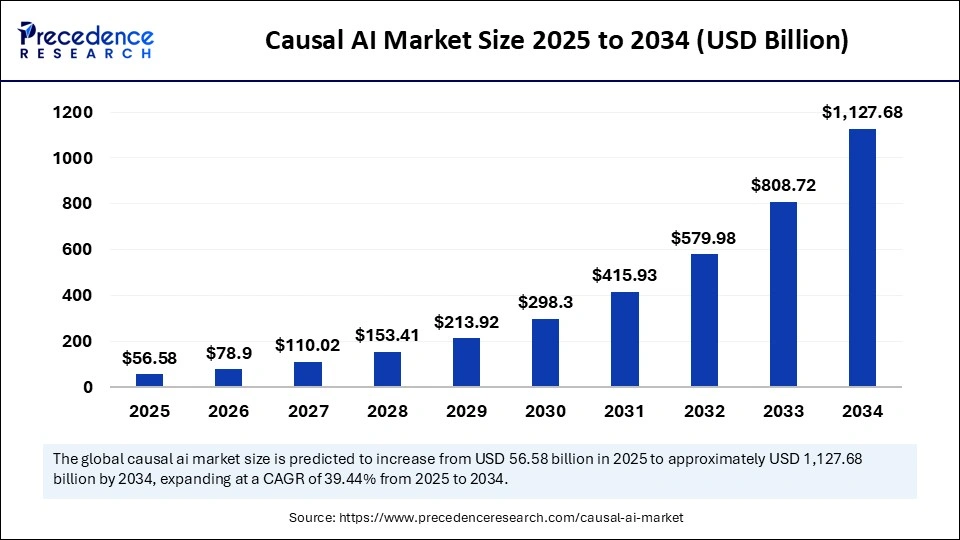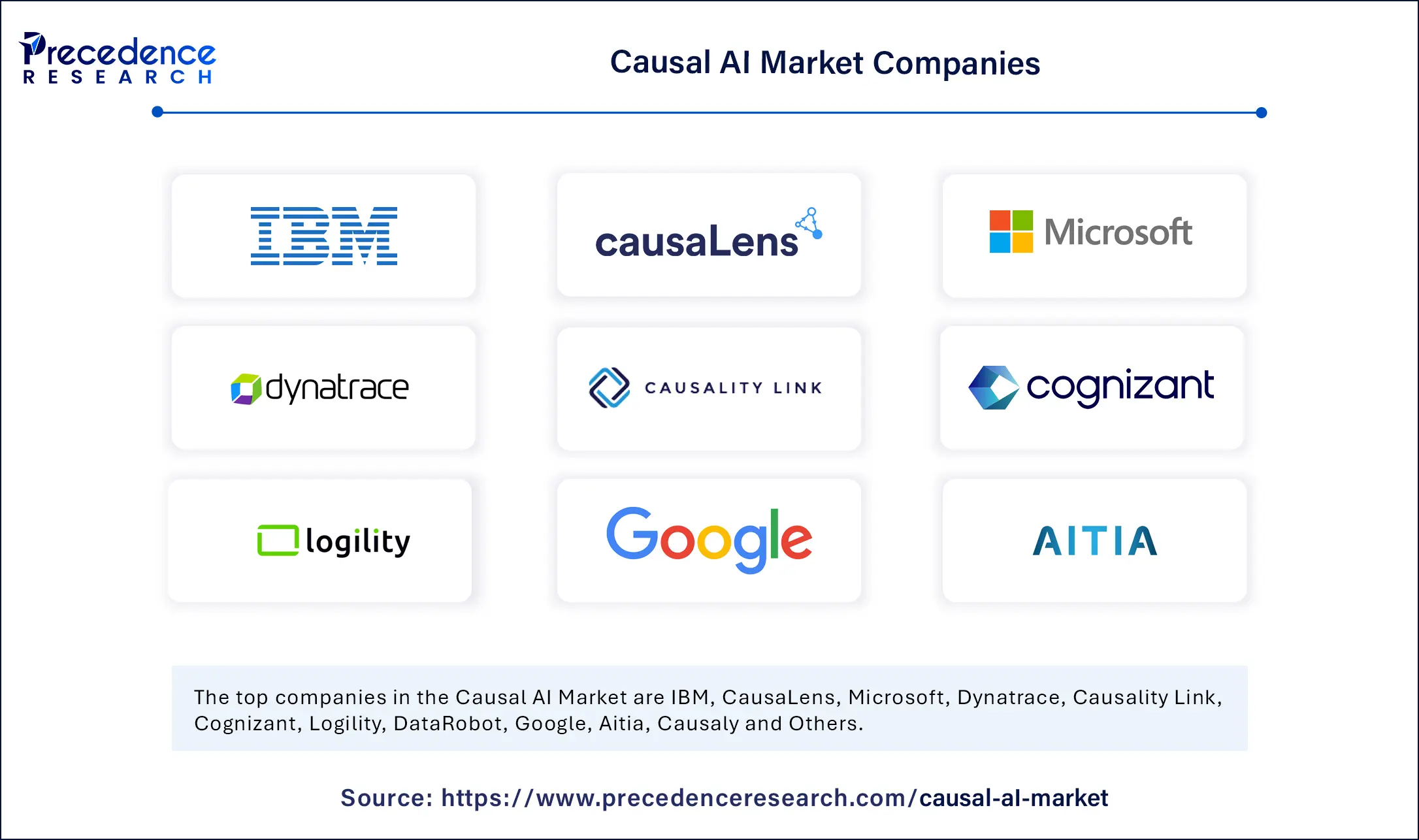
Causal AI Market Key Points
-
North America dominated the global causal AI market in 2024, accounting for the largest share of 42%.
-
The Asia Pacific region is anticipated to grow at the fastest CAGR between 2025 and 2034.
-
By deployment, the cloud segment secured the largest market share of 56% in 2024.
-
The hybrid deployment segment is projected to register the fastest CAGR over the forecast period.
-
Based on technology, the causal inference engine segment led the market with the highest share in 2024.
-
The counterfactual simulation tools segment, by technology, is expected to witness the fastest growth in the coming years.
-
By end-user, the healthcare and life sciences segment held the dominant share of the market in 2024.
-
The financial services segment is projected to expand at the fastest CAGR throughout the forecast period.
Causal AI Market Overview
The causal AI market represents one of the most advanced frontiers in artificial intelligence, offering a transformative shift from correlation-based machine learning models to systems capable of understanding cause-and-effect relationships. Unlike traditional AI systems that rely heavily on statistical associations and pattern recognition, causal AI leverages causal inference techniques to determine not just what is happening, but why it is happening. This capability allows organizations to make more robust predictions, simulate interventions, and generate actionable insights across a wide range of industries including healthcare, finance, manufacturing, marketing, and public policy.
Causal AI is emerging as a critical tool for decision intelligence—enabling AI systems to go beyond surface-level trends and provide prescriptive recommendations based on “what-if” scenarios. For example, rather than just identifying that a drop in sales is correlated with reduced marketing spend, causal AI can determine whether one causes the other and predict the outcome of increasing or decreasing the budget. This enhanced interpretability and reliability make causal AI ideal for high-stakes environments where trust, compliance, and transparency are essential. As businesses seek to gain deeper insights and move toward automation with accountability, the causal AI market is expected to expand significantly over the coming decade.
Causal AI Market Growth Factors
The growing demand for explainable and interpretable AI solutions is one of the core growth factors driving the causal AI market. As enterprises integrate AI into mission-critical processes, there is increasing pressure to understand how decisions are made—especially in regulated sectors such as healthcare, insurance, and finance. Causal AI provides the necessary frameworks to make machine learning models more transparent, helping organizations meet ethical and regulatory standards.
Another major growth factor is the rising need for decision-centric AI in environments where actions must be optimized based on potential outcomes. Businesses want to test strategies before implementation—such as changing a pricing model, launching a marketing campaign, or adjusting a supply chain process. Causal AI empowers such experimentation through counterfactual analysis and intervention modeling, reducing business risk and improving ROI.
Additionally, the integration of causal inference into existing data science and machine learning pipelines is becoming increasingly feasible thanks to advancements in open-source frameworks and enterprise-grade platforms. As companies gain access to larger and richer datasets, including time-series and longitudinal data, causal AI techniques become more effective and easier to apply.
The growing interest in hybrid AI systems, where causal inference is combined with deep learning, reinforcement learning, and symbolic reasoning, is also contributing to market momentum. This hybridization allows causal AI to be applied to complex, real-world scenarios such as autonomous systems, personalized healthcare, fraud detection, and marketing attribution.
Impact of AI on the Causal AI Market
Causal AI itself is a specialized evolution within the broader AI landscape, but its impact on the AI market as a whole is both foundational and transformative. Traditional AI models operate primarily on correlation; while this has enabled tremendous progress in pattern recognition, it limits the model’s usefulness when it comes to understanding dynamics in real-world systems. Causal AI addresses this gap by integrating domain knowledge, structural modeling, and reasoning capabilities, fundamentally altering how AI is applied in critical decision-making processes.
The impact of causal AI is especially pronounced in strategic decision-making and policy evaluation, where understanding the cause of a problem or the projected effect of an intervention is more important than just prediction accuracy. In healthcare, for example, causal AI allows researchers to simulate the effect of drug combinations on different patient populations. In financial services, it helps banks assess the real drivers of loan defaults and compliance violations. In supply chains, it can simulate how changes in logistics, pricing, or weather conditions affect product delivery.
By enabling counterfactual analysis—what would have happened under a different set of conditions—causal AI significantly enhances the trustworthiness, fairness, and interpretability of AI systems. It enables organizations to avoid algorithmic biases, validate model behavior, and comply with increasingly stringent AI governance frameworks. As AI becomes embedded into autonomous agents and decision-support tools, causal AI’s ability to offer explainable, intervention-aware insights will become central to enterprise and public-sector AI strategies.
Market Scope
| Report Coverage | Details |
| Market Size by 2034 | USD 1,127.68 Billion |
| Market Size in 2025 | USD 56.58 Billion |
| Market Size in 2024 | USD 40.58 Billion |
| Market Growth Rate from 2025 to 2034 | CAGR of 39.44% |
| Dominating Region | North America |
| Fastest Growing Region | Asia Pacific |
| Base Year | 2024 |
| Forecast Period | 2025 to 2034 |
| Segments Covered | Deployoment, Technology, End User, and Region |
| Regions Covered | North America, Europe, Asia-Pacific, Latin America, and Middle East & Africa |
Market Drivers
Several key drivers are propelling the growth of the causal AI market. First is the growing need for causality in business forecasting and planning. Traditional analytics and machine learning approaches often fail to differentiate between correlation and causation, leading to flawed decision-making. Organizations now seek AI models that can suggest not only what is likely to happen but also how to influence future outcomes effectively.
The second major driver is the increasing regulatory and compliance burden on AI systems. Laws such as the EU AI Act, GDPR, and emerging frameworks in North America and Asia are pushing for greater transparency and accountability. Causal AI provides a mechanism for explaining AI outcomes, making it highly attractive for use cases where auditability and traceability are paramount.
Another significant driver is the rising use of simulation and digital twin technologies in manufacturing, logistics, and healthcare. Causal AI enhances these technologies by allowing them to test interventions in silico before applying them in real-world operations. Furthermore, the shift toward automation of decision-making processes—whether in marketing personalization or autonomous systems—necessitates the use of AI that can reason, not just react.
Finally, the academic and technological maturation of causal inference methodologies, including Bayesian networks, structural causal models (SCMs), and Granger causality, has enabled practical applications at scale. Increased investment from leading AI research labs, venture capitalists, and cloud providers is accelerating commercialization and adoption.
Opportunities
The causal AI market is ripe with opportunities across industries and technical applications. One of the most immediate opportunities lies in integrating causal AI with business intelligence platforms, enabling enterprises to perform root cause analysis and intervention simulations directly within their existing dashboards. Vendors that offer plug-and-play APIs or causal analytics modules for platforms like Tableau, Power BI, or Salesforce can quickly gain market traction.
There’s also significant opportunity in healthcare and life sciences, where causal AI can transform drug development, clinical trial analysis, and personalized treatment planning. In marketing, causal AI can unlock accurate attribution modeling, allowing companies to optimize campaigns and customer journeys with greater confidence.
Another growing opportunity is in the governance of AI ethics and fairness. Causal AI allows for precise identification of biased outcomes and provides evidence-based solutions to mitigate them. This positions it as a critical component of ethical AI toolkits for HR, law enforcement, education, and credit scoring.
Causal AI also presents opportunities in climate modeling, energy optimization, and policy impact analysis. Governments and NGOs can use these tools to simulate the effects of environmental regulations, subsidy programs, or urban planning decisions. With the rise of climate tech and ESG (environmental, social, and governance) mandates, causal AI stands to play a vital role in sustainability initiatives.
Challenges
Despite its promise, the causal AI market faces several substantial challenges. One major obstacle is the complexity of causal modeling, which often requires deep statistical expertise and domain knowledge. Compared to correlation-based machine learning, implementing causal models is more technically demanding, and many organizations lack the talent or resources to deploy them effectively.
Another barrier is the lack of standardized tools and frameworks, although this is improving with emerging libraries like DoWhy, CausalNex, and Microsoft’s EconML. The data quality and completeness required for accurate causal inference is also higher, as missing variables or incorrect model assumptions can compromise results.
Adoption is further slowed by resistance to change within enterprises, where existing ML and analytics pipelines are entrenched and optimized for correlation-based methods. The additional time, cost, and cultural shift required to implement causal AI can be a deterrent unless the business case is clearly demonstrated.
Finally, educational gaps and low awareness among decision-makers and analysts remain a challenge. Many stakeholders still equate all AI with black-box prediction and are unfamiliar with the advantages and use cases of causal AI. Overcoming this will require vendor-led education, industry case studies, and stronger integration with mainstream AI platforms.
Regional Outlook
North America currently leads the causal AI market, owing to strong R&D capabilities, early adoption of advanced AI, and the presence of key players such as Microsoft, IBM, Google, and several startups specializing in decision intelligence. The U.S. government’s focus on explainable and trustworthy AI for public-sector applications also fuels growth in sectors like defense, healthcare, and finance.
Europe is rapidly gaining ground, driven by stringent data governance regulations and widespread adoption of ethical AI principles. The EU’s digital strategy encourages transparency and interpretability, making causal AI particularly relevant. Countries like the UK, Germany, and France are investing heavily in AI research hubs and academic-industry partnerships.
Asia Pacific is an emerging hotspot, with countries like China, Japan, Singapore, and South Korea advancing their AI infrastructure. While adoption of causal AI is still in early stages, growing government support, digital transformation in manufacturing, and AI innovation in healthcare and fintech make the region a promising long-term market.
Latin America and Middle East & Africa are still nascent markets for causal AI but show potential as cloud-based AI tools become more accessible and as governments begin implementing AI for policy and development goals. These regions could benefit significantly from causal AI in agriculture, healthcare access, and education policy, but challenges such as data quality, infrastructure, and expertise may delay near-term adoption.
Causal AI Market Companies

Segments Covered in the Report
By Deployment
- Cloud
- On-premises
- Hybrid
By Technology
- Causal Inference Engines
- Structural Causal Models (SCM)
- Counterfactual Simulation Tools
- Graph-Based Causal Modeling
- Others
By End-User
- Healthcare & Life Sciences
- Financial Services
- Retail & E-commerce
- Manufacturing
- Government & Public Sector
- Technology & IT Services
- Others
By Region
- North America
- Europe
- Asia Pacific
- Latin America
- Middle East and Africa (MEA)
Read Also: Mobile Identification Market
Get this report to explore global market size, share, CAGR, and trends, featuring detailed segmental analysis and an insightful competitive landscape overview @ https://www.precedenceresearch.com/sample/6249
You can place an order or ask any questions, please feel free to contact at sales@precedenceresearch.com|+1 804 441 9344